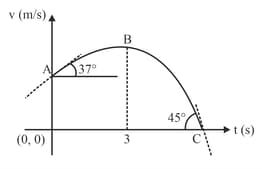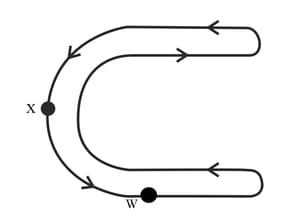Acceleration
Acceleration: Overview
This topic covers concepts, such as, Instantaneous Acceleration and Average Acceleration etc.
Important Questions on Acceleration
A body is moving with velocity towards east. After 10 seconds its velocity becomes towards north. The average acceleration of the body is
A particle moves along a straight line such that its displacement at any time t is given by metres. The velocity when the acceleration is zero is
A particle is moving eastwards with a velocity of . In , the velocity changes to northwards. The average acceleration in this time is
For a body moving on a straight line if is position coordinate and is time then acceleration of body is constant when -
(1) and velocity is linear
(2) and square of velocity is linear
(3) and velocity is linear
(4) and square of velocity is linear.
A particle of mass moves in a straight line with retardation where is the displacement in units. Its loss of kinetic energy for above displacement is The value of will be
At any instant the velocity of a particle of mass is . If the force acting on the particle at is . Then the value of will be:
If position vector of a particle is given by , then the correct statement about the acceleration of the particle is
A bock of mass is placed on smooth surface, moves with acceleration of , then the change in kinetic energy can be given as , find the value of .
Velocity of a particle moving along x-axis varies with time as . Find the average acceleration of the particle from to .
A particle moves in a straight line under an acceleration varying linearly with time. Its velocity-time graph is shown here. Tangent to point and makes an angle of and with positive -axis respectively. Then

At , a particle at the origin has a velocity of at above the horizontal -axis. At , it is at and and its velocity is at above the horizontal. Find
(a) its average velocity :
(b) its average acceleration.
A body moves with velocity , where is its position. Acceleration of body is zero at
If particle starts from rest at . Find
(i)
(ii) at
Displacement as function of time is given as . Find at which its acceleration is .
Assertion: The zero velocity of a particle at any instant always implies zero acceleration at that instant
Reason: A body is momentarily at rest when reverses its direction of motion.
The correct option among the following is
Velocity of a particle moving along -axis varies with time as where is in seconds. The average acceleration of the particle from to is
A car moves with constant speed around a horseshoe-shaped path as shown with the arrows in the figure. Which one of the following choices best describes the direction of the average acceleration of the car in travelling from W to X?

The displacement of a particle at time along a straight line is given by . Find the acceleration of the particle.
The acceleration-time graph of a body starting from rest is shown below

The average acceleration of the body from to is
The acceleration of a body starting from rest varies with time following the equation . The velocity of of the body at time is
